Beehive Ventilation
Any conversation among beekeepers will turn up the topic of beehive ventilation sooner or later. There are many strategies used to increase fresh airflow inside the beehive. From the use of screened bottom boards to adding more ventilation holes, we strive to help our bees feel comfortable. Bees need a certain amount of warmth but they will die of poor hive ventilation.
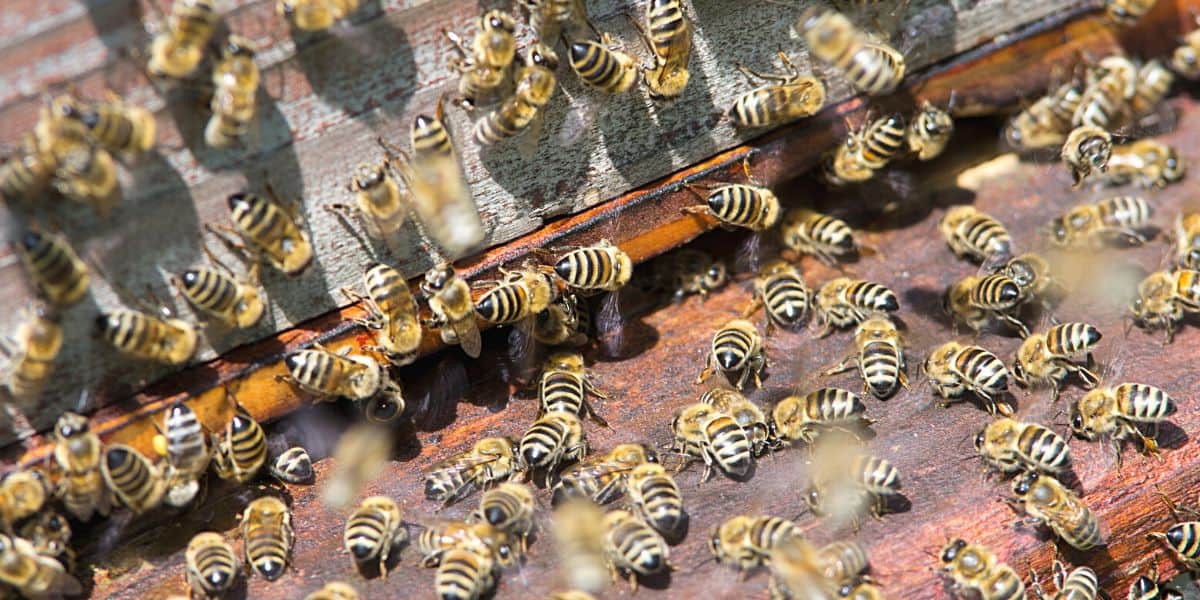
Like most aspects of managing honey bees, there must be a balance in hive ventilation. Wrapping hives to keep them warm in the Winter, as well as, adding extra ventilation for air flow – both can be overdone.
Why Poor Hive Ventilation is a Killer
We must remember that the anatomy of a honey bee (body parts) and that of humans is very different. Just because you feel hot and sticky, that does not mean that your honey bees feel the same.
Inside the brood area, baby bees are kept within a certain temperature range and humidity level. Around 92.6°F is the common given temperature of the brood nest.
This allows, eggs, growing bee larvae and capped brood to survive. Due to brood thermoregulation, the cluster is able to sustain heat without warming the whole inside of the hive cavity.
As beekeepers, we strive to manage our colonies in a way to help them – help themselves. But, thank goodness bees have a pretty good system of managing things on their own.
Still we are keeping them in man-made hives. That is much different than hollow trees that they would pick on their own.
Air flow is important to the colony. When bees are building their sheets of honeycomb, this is done in a way to facilitate air movement. This makes controlling the temperature and humidity inside easier for the colony.
Modern Beehives Lack Insulation Value
The honey bee colony has a marvelous system for maintaining the proper atmosphere inside the hive. Early hive designs had some features that aided in moisture control or insulation.
However, our modern beehives are mass produced for cost effectiveness. They are not as thick and insulated as natural hives. This allows the colony to be more affected by temperature swings.
Fanning at Hive Entrance
The hive entrance is another important location for beehive ventilation. On very warm days you will see many bees lined up at the open entrance. This is natural ventilation.
Worker bees stand at the entrance and fan their wings to create airflow through the hive. This fanning response brings in cooler air and expels hot moist air from inside the hive.
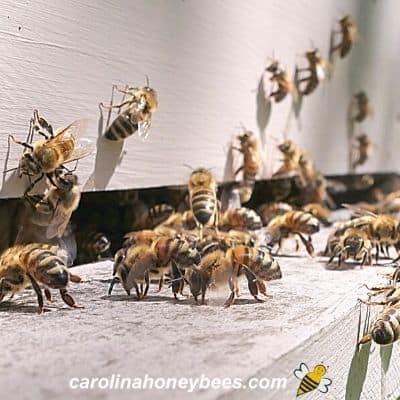
The Dangers of Condensation
Without proper air flow, moisture may build up inside the hive. However, the bees need some moisture in the hive.
Droplets of water are placed on the surface of comb and air passes over creating a cooling affect – a bee air conditioner of sorts. So, a little excess moisture in Summer can be an asset.
However the cooler outside temperatures of Winter, combined with rising warm moist air can create a cold rain inside the hive. Condensation can be a hive killer in cold weather.
Bees Bearding at the Entrance
Many new beekeepers panic upon seeing masses of honey bees bearding at the front of the hive. The first thought is that the honey bees are swarming and your bees are on their way out!
Fortunately, this is not usually the case. When the temperatures climb and especially when humidity is high, the colony has more difficulty controlling the environment inside.
At the end of the day, when the ambient temperature is highest, returning foragers will often cling together outside the hive entrance.
Fewer bee bodies inside means air flow is easier to maintain. As the evening cools, most of the bees will go in. This is completely natural and nothing to be concerned about.
However, increasing hive ventilation may lessen the occurrence of bearding. I use special ventilated top boxes to give my colonies ventilation during our hot Summers – this helps cool the beehive.
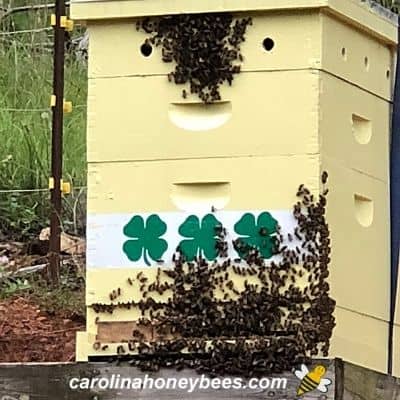
Techniques Used to Ventilate the Summer Hive
Honey bees (Apis mellifera) are cold blooded social insects-they like warm weather- but they do have heat tolerances.
Extremely high temperatures causes death of bee brood and may cause sections of honeycomb to collapse. The colony with proper ventilation will be healthier and more productive.
Whether your hives are located in the shade or full sun, there may be times when you are concerned about the Summer heat.
Unless you live in a very hot region, your bees are capable of managing hive ventilation on their own.
However, because we are keeping our bees in man-made boxes, there are some techniques you can try to help them.
- Use a hive stand
- Screen Bottom Boards
- Inner Covers (Notched, or Screened)
- Providing Shade
- Propping up outer cover with craft sticks
- Drilling extra holes in bee boxes

Stands Raise Hive Up Off Ground
Using a hive stand is beneficial to the beekeeper in many ways. It is certainly a back saver when lifting those heavy boxes or leaning over during hive inspections.
In addition, raising the hive up off the ground allows air to flow completely around the boxes. This increased air circulation also reduces excess moisture that may be absorbed from the soil.
Screened Bottoms Make Help
While screened bottom boards, are not the perfect ventilation (because the of the way bees move air through the hive), they do aid in temperature control.
Compared to a solid bottom board, more heat will escape through the bottom. Even beekeepers in hot regions report fewer instances of comb melting in hives with a bottom screen instead of a solid.
Small Adjustments of Inner Cover
An important part of any standard beehive is an inner cover. This piece goes between the outer top cover and the top box.
In a regular wooden inner cover, the middle hole lets out hot air and the notch on one end does too.
With the inner cover used in a notch up position, some hot air will flow out of the boxes. To aid in this be sure to push your outer top cover forward allowing a little space at the front of the hive near the notch.
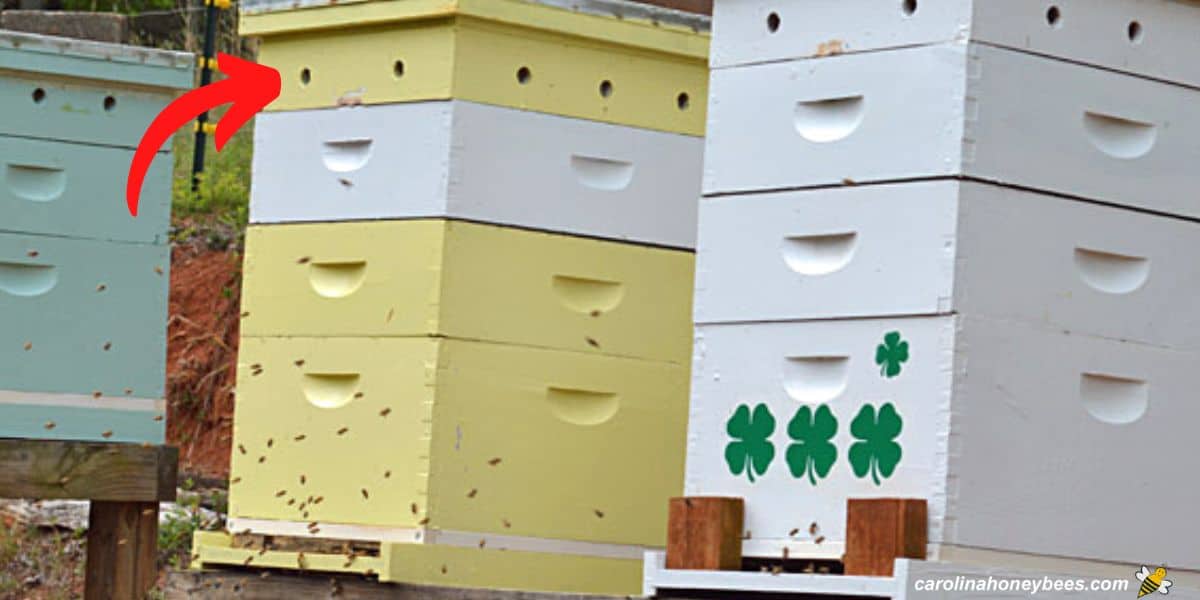
A common approach to hive ventilation is the use of popsicle or craft sticks. Placing one at each corner of the inner cover raises the outer cover up just a bit to aid in fresh air. But the space is not big enough for bees to enter.
It gets really hot here and deep shade is not an option due to the Small Hive Beetles. In addition to hive stands and screened bottom boards – I use special inner covers with screened holes. You can do something similar by adding a shallow bee box above your regular inner cover.
Light Shade is a Plus
If you live in a very hot area, creating some extra shade for Summer may be beneficial. This prevents extreme temperatures in the hive and may keep the beekeeper from passing out in his/her beekeeping suit!
However, in general your bees do not need a lot of shade and hives can do well in full sun.
Holes in Boxes
Another technique is the use of screened holes in the top boxes. A couple of 1-inch holes are drilled in the box and screen applied inside to make it bee proof.
These can be effective but your bees may propolis the holes closed. I have a personal aversion to drilling holes in good boxes. However, some beekeepers have good success with this technique.
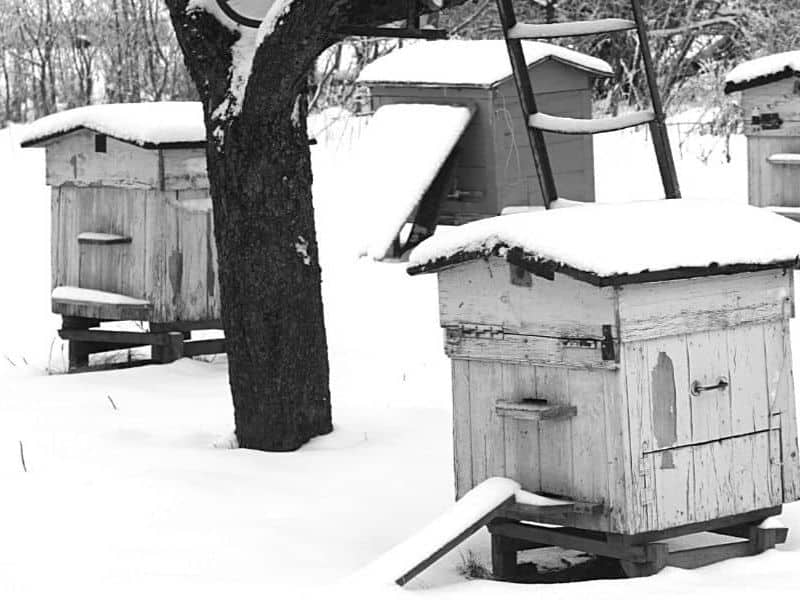
Winter Beehive Ventilation for Moisture Control
We know that our honey bees form a cluster to stay warm inside the hive during the cold days of Winter. The hard work of Summer to collect nectar and make honey provides food for Winter survival.
However, the beekeeper must consider moisture regulation inside the Winter beehive. Water content that is useful inside the hive during Summer can become a Winter bee killer.
Having an upper entrance in the hive, especially at the top can help remove excess moisture. Normally, air enters the beehive through the bottom opening and flows upwards. Having a small opening at the top helps this warm moist air escape.
This is one of the reasons it is not a good idea to feed bees liquid during Winter. Prepare your colonies before cold arrives. Don’t add more moisture inside.
In colder regions, beekeepers may wrap their hives with additional material to aid in temperature control.However, we do not want to wrap (or insulate) the hives up too tight and keep moisture inside.
If you keep bees in a region known for very cold or cold damp Winter weather, the use of a moisture quilt box may help. A box is added to the top of the colony with absorbent materials such as straw or shavings.
Through out the Winter, very damp air rises and is absorbed in the quilt box materials rather than condensing on the cover and raining back down on the bees.
FAQs
There are several ways to provide additional ventilation to a beehives. Some of the most common are: provide an upper entrance, raise the outer cover up off the boxes just a tiny bit with popsicle sticks or drill a couple of holes in the top boxes and add screen on the inside.
Warm moist air inside the hive rises towards the top. With no escape, it may condense on the inner cover and drip back down on the bees in cold weather. Ventilation also helps the bees maintain proper internal hive temperatures in the Summer.
Whether or not to provide extra ventilation for your beehive depends on your climate. If you live in a wet, cold climate – it becomes more important.
Final Thoughts
Life in the colony is all about balance. If the temperature is too cold, bees die. When inside conditions are too hot, many of the bees move outside the hive.
Excess moisture inside during Summer makes honey ripening more difficult. However, condensation in Winter can chill bees and cause colony failure.
Sensible techniques by the beekeeper to aid in beehive ventilation can prevent many of these problems. This leads to a healthier honey bee colony.

